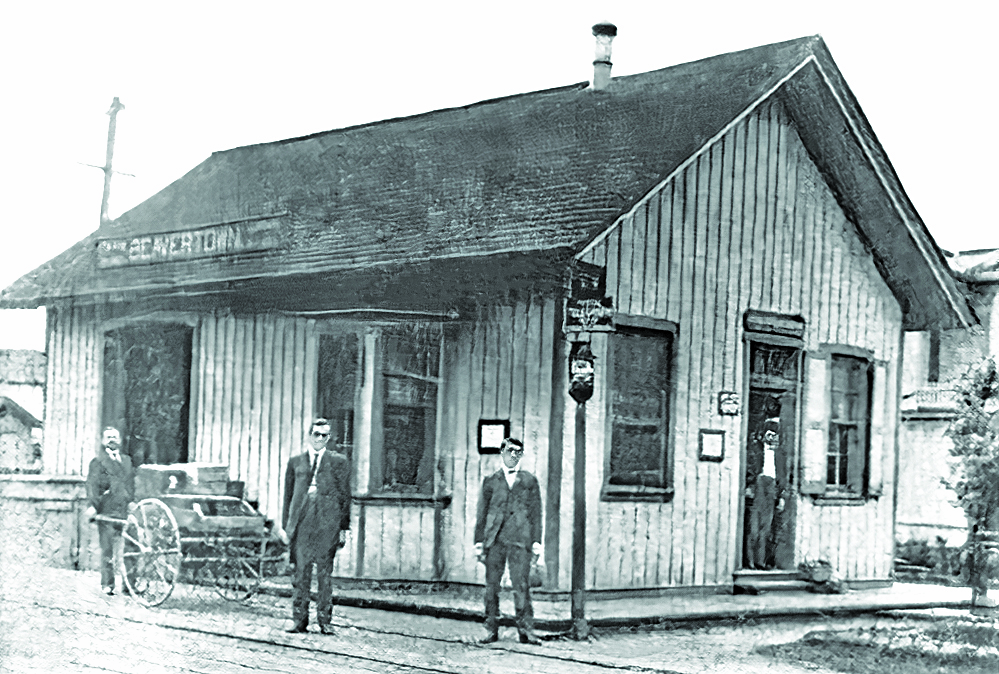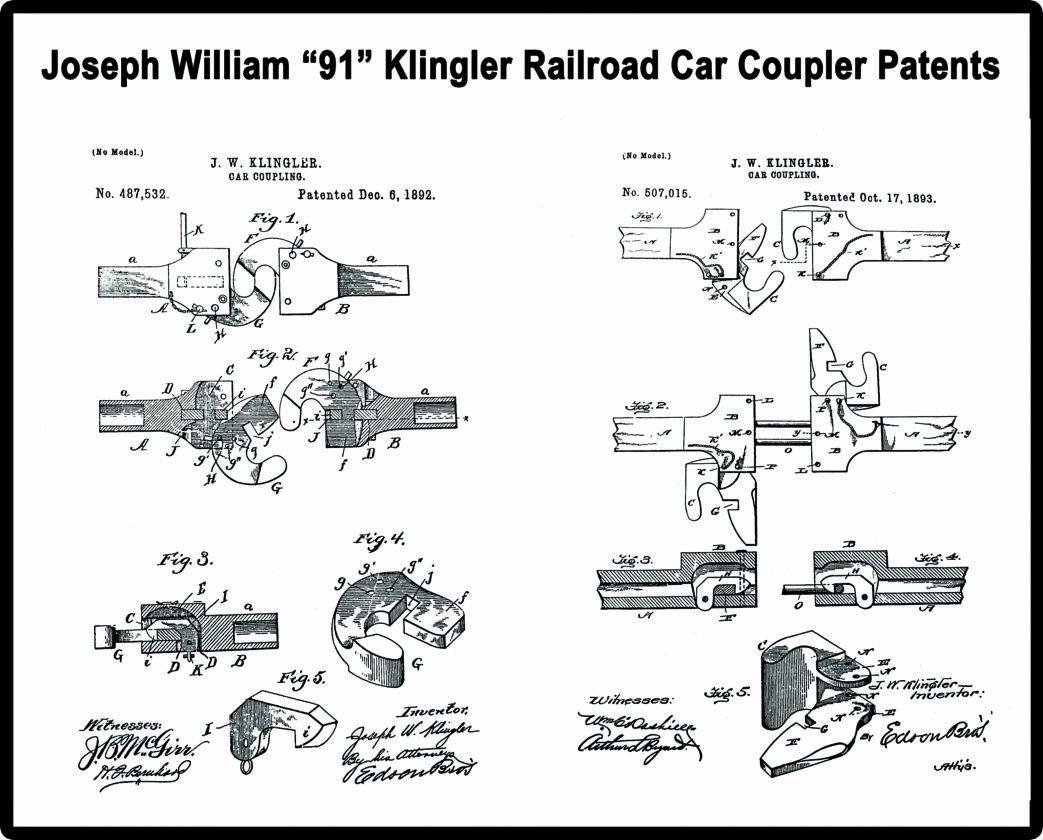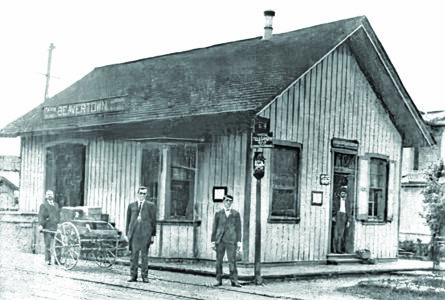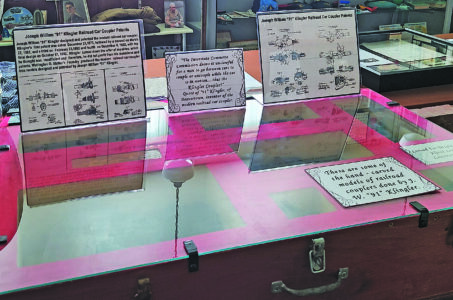Museum opens railroad exhibit
Sunbury and Lewistown Railroad on display
- Photo courtesy of BEAVERTOWN HISTORICAL SOCIETY An undated photo of the old Beavertown Railroad Station.
- Photo courtesy of BEAVERTOWN HISTORICAL SOCIETY An exhibit at the Beavertown Historical Society Museum of the display and patents for the Joseph WIlliam ‘91’ Klinger’s Car Coupler.

Photo courtesy of BEAVERTOWN HISTORICAL SOCIETY An undated photo of the old Beavertown Railroad Station.
BEAVERTOWN — The Sunbury and Lewistown Railroad was far from just a means of transportation; it provided a way for smaller communities to stay connected with the wider world.
From the late 1800s through the early 1900s, the railroad provided passenger service, linking Beavertown to Lewistown, Harrisburg, Sunbury and beyond.
“The railroad was Beavertown’s lifeline to the outside world,” said Karen Burns, president of the Beavertown Historical Society. “It connected our small town to larger markets, brought new goods into local stores, and allowed local farmers and businesses to thrive.”
The historical society is featuring a special exhibit which highlights the history and impact of the Sunbury & Lewistown Railroad on Beavertown and the surrounding communities through Sunday, Nov. 23.
The display, now open at the Beavertown Historical Museum, explores how the railroad shaped daily life.

Photo courtesy of BEAVERTOWN HISTORICAL SOCIETY An exhibit at the Beavertown Historical Society Museum of the display and patents for the Joseph WIlliam ‘91’ Klinger’s Car Coupler.
“The historical society’s exhibit not only tells the story of the railroad itself but also the people and businesses whose lives it transformed,” Burns added.
For many families in the Snyder County town, it was the first reliable means of long-distance travel.
In the mid-1860s, residents of Snyder County wanted to capitalize on the transportation and commerce possibilities of the recently constructed Northern Central Railway, which was located across the Susquehanna River in Northumberland County.
The Northern Central, completed in the 1850s, connected Sunbury to Harrisburg, York and Baltimore, Md., thus giving Snyder County a better connection to the surrounding region and beyond.
The Middle Creek Railroad was formed in Selinsgrove in 1868, with the intention of planning, grading and constructing a route. Without any ties to a major railroad, the Middle Creek Railroad only got as far as choosing the route and the completion of some grading before the company ran out of money and folded.
The assets of the company were bought up and reorganized as the “Sunbury & Lewistown Railroad” in 1871. With minimal initial financial backing from the Pennsylvania Railroad (PRR) and Northern Central Railway, construction of the nearly 50-mile line continued at a slow pace for the next three years, with work progressing inward from both the eastern and western termini.
The western group covered more territory, as the completion of the line’s eastern end was contingent on the construction of the half-mile-long Selinsgrove Bridge spanning the Susquehanna River. The PRR signed a 99-year lease on the line in October 1871 and purchased half the outstanding stock of the line, and the entire line was completed in December 1871.
Almost immediately, it became clear that the demand for such a line was not as high as its proprietors had anticipated, and the railroad ceased to operate. The line was sold at sheriff’s sale in May 1874, and reorganized as the Sunbury & Lewistown Railway on Feb. 1, 1876.
For more than 80 years, the line operated between Sunbury and Lewistown, serving as a relief line for both the Philadelphia Main Line and Bald Eagle Valley Railroad through Williamsport.
The line was noteworthy as a proving ground for new railroad technology in the United States, such as the X-shaped railroad crossing signs in 1917 (now nearly ubiquitous in the United States) and Pulse Code Cab Signaling technology in 1925.
It is now a fallen flag railway, the name “Sunbury & Lewistown” having been phased out in 1901 when the line became part of the PRR’s Sunbury Division.
The exhibit showcases artifacts, photographs and documents connected to the railroad, including items that were transported to and from Beavertown during its years of operation.
Residents once relied on the trains for vital deliveries such as coal, lumber, hardware, groceries, farm equipment, dry goods and medicine. In return, the trains carried away agricultural products, livestock, timber, bricks and manufactured goods produced in the region.
Visitors to the museum will see examples of goods transported by train as well as William Joseph “91” Klingler’s railroad car coupler. On display are a few wooden models of the couplers he patented between 1875 and 1893, generously loaned to the museum by Fred Lerch.
Many other wonderful Pennsylvania Railroad artifacts are also on display, thanks to a loan from Darwin Aurand.
“We invite everyone to stop by, especially those with ties to Beavertown or an interest in railroads,” Burns said. “This exhibit is a chance to step back in time and appreciate how the Sunbury & Lewistown Railroad shaped the everyday lives of our community.”
Located at 111 W. Walnut St., Beavertown, the Beavertown Historical Museum, is open from 1 to 3 p.m. on the following Sundays: Sept. 28, Oct. 12 and 26 and Nov. 9 and 23.
Admission is free, but donations are always welcome to support the preservation of local history.




